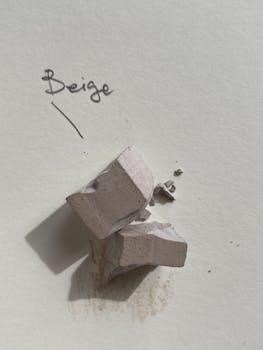CSWIP 3.2 Senior Welding Inspector Certification⁚ Study Material and Exam Preparation
The CSWIP 3.2 certification requires thorough preparation, including study materials like PDF documents and pre-learning packages. These resources cover topics such as welding theory, product technology, and quality control to help candidates succeed in the exam.
CSWIP 3.2 Certification Overview
The CSWIP 3.2 Senior Welding Inspector certification is a highly regarded qualification for experienced professionals in the welding industry. It signifies a high level of competence in welding inspection and quality control. This certification is more comprehensive than CSWIP 3.1, specifically tailored for senior inspectors with extensive experience. It is an industry benchmark, ensuring that certified individuals possess the necessary knowledge and skills. The program requires candidates to demonstrate a deep understanding of various welding processes, materials, and inspection techniques. Successful completion of the CSWIP 3.2 certification enhances career prospects and is often a prerequisite for senior roles in quality assurance. It includes theoretical and practical examinations, assessing a broad range of topics. The qualification is recognized as a measure of competence, and maintaining certification requires ongoing professional development. For those seeking to advance their careers, it is a significant step.
Eligibility for CSWIP 3.2

To be eligible for the CSWIP 3.2 Senior Welding Inspector certification, candidates must meet specific criteria, focusing primarily on experience and prior qualifications. A minimum of two years of experience as a Certified Welding Inspector (Level 2) with responsibilities in areas such as welding inspection, quality control, and documentation is typically required. This demonstrates a practical understanding of welding processes and related quality assurance measures. Candidates must possess a solid grasp of welding procedures, materials, and non-destructive testing methods. Additionally, some programs may require candidates to have a current CSWIP or PCN Radiographic Interpreters certificate. Eligibility also involves having job responsibilities in welding-related activities. It is crucial for prospective candidates to review the latest CSWIP document, specifically WI-6-92, for detailed requirements before enrolling in the certification program. The goal is to ensure that candidates have sufficient experience and expertise to benefit from the advanced training.
CSWIP 3.2 Exam Structure
The CSWIP 3.2 examination is designed to comprehensively assess a candidate’s knowledge and skills as a senior welding inspector. The exam consists of four distinct sections, each requiring a minimum passing score of 70%. The first section is a multiple-choice test focusing on general welding theory, product technology, and non-destructive testing (NDT). This section contains 30 questions with a time limit of 45 minutes. The second section involves scrutinizing and commenting on four inspection-related documents, also multiple-choice, containing 40 questions with a 75-minute time allocation. The third part assesses the candidate’s ability to interpret fabrication drawings, with 10 multiple-choice questions in 20 minutes. Finally, the fourth section consists of 60 multiple-choice questions based on TWI specifications, allowing 90 minutes for completion. The overall structure ensures that candidates are proficient in a wide range of welding inspection and quality control principles.
Multiple Choice Questions
The CSWIP 3.2 exam heavily relies on multiple-choice questions to assess a candidate’s theoretical understanding. These questions are distributed across several sections of the examination, testing various aspects of welding inspection; The first section dedicated to general welding theory, product technology, and NDT, comprises 30 multiple-choice questions to be completed within 45 minutes. Additionally, there are 40 multiple-choice questions focused on document scrutiny and interpretation, with a 75-minute time limit. Furthermore, the TWI specification section contains 60 multiple-choice questions, providing 90 minutes for completion. These questions require a thorough grasp of welding processes, materials, procedures, and quality control. Candidates must be prepared to apply their knowledge to various scenarios and problems presented in the multiple-choice format.
Document Scrutiny and Interpretation
A crucial part of the CSWIP 3.2 examination involves document scrutiny and interpretation. This section evaluates the candidate’s ability to thoroughly analyze and understand inspection-related documents. This part of the exam contains 40 multiple-choice questions that must be completed within 75 minutes. Candidates are required to scrutinize four documents and provide detailed comments on their content, paying close attention to specific details and implications. These documents may include welding procedure specifications, inspection reports, quality control plans, and other relevant paperwork. The ability to accurately interpret these documents is essential for effective welding inspection. The assessment evaluates the candidate’s skill in identifying inconsistencies, errors, and deviations from specified standards and procedures.
Fabrication Drawing Interpretation
The fabrication drawing interpretation section of the CSWIP 3.2 exam assesses a candidate’s ability to understand and interpret technical drawings related to welding and fabrication. This segment of the test includes 10 multiple-choice questions with a 20-minute time limit. Candidates are expected to demonstrate their proficiency in extracting critical information from these drawings. This includes identifying weld symbols, dimensions, material specifications, and other relevant details necessary for proper fabrication and inspection. The ability to accurately interpret fabrication drawings is fundamental for any welding inspector to ensure that welds are completed in accordance with the design specifications and requirements. A strong understanding of these drawings ensures quality control and adherence to set standards.
TWI Specification Questions
The TWI Specification questions section of the CSWIP 3.2 exam is a crucial part, focusing on the candidate’s knowledge of TWI (The Welding Institute) standards and specifications. This section comprises 60 multiple-choice questions, with a 90-minute time limit. It evaluates the candidate’s understanding of the specific requirements and guidelines set forth by TWI, which are essential for ensuring quality in welding and fabrication processes. A thorough knowledge of these specifications is vital for senior welding inspectors who must ensure compliance and maintain high standards of welding integrity. Candidates need to be proficient in applying this knowledge to various welding scenarios. The questions may cover different aspects of TWI specifications and their practical applications. This section will assess if the candidate can effectively use TWI documents as part of their daily inspection activities.
CSWIP 3.2 Exam Sections and Passing Marks
The CSWIP 3.2 examination is structured into four distinct sections, each designed to assess different aspects of a senior welding inspector’s competency. A passing mark of 70% is required in each of these sections to achieve certification. The first section focuses on general welding theory, product technology, and non-destructive testing, presented as 30 multiple-choice questions. The second section evaluates the ability to scrutinize and comment on four inspection-related documents, consisting of 40 multiple-choice questions. The third section is focused on the interpretation of fabrication drawings, with 10 multiple-choice questions. The final section includes 60 multiple-choice questions based on TWI specifications. Each section’s time limit is different, but each section is equally important to pass to be certified. This comprehensive approach ensures that only the most qualified candidates achieve certification.
CSWIP 3.2 Pre-Learning Packages
To enhance preparation for the CSWIP 3.2 Senior Welding Inspector examination, TWI offers online pre-learning packages. These packages are designed to familiarize candidates with the course syllabus and exam format before attending the formal training. The pre-learning materials typically cover a range of topics from general welding theory to specific aspects of quality control and inspection procedures. These resources are invaluable in providing a foundational understanding and can significantly improve a candidate’s performance during the actual course and exam. By using these pre-learning packages, candidates can efficiently manage their study time and identify areas where they need to focus their efforts. The packages often include practice questions and exercises to simulate the exam environment, enabling candidates to approach the exam with more confidence.
CSWIP 3.2 Preparatory Training
Preparatory training courses are crucial for candidates aiming for the CSWIP 3.2 certification. These courses delve into the syllabus, ensuring a comprehensive understanding of all required topics. The training is designed to help candidates grasp the subjects thoroughly and prepares them for the exam effectively. It often includes practice exams, aiding participants in familiarizing themselves with the test format and time constraints. The training covers all modules of the syllabus, ensuring no aspect is left unaddressed. Such rigorous preparation helps candidates build a solid base of knowledge, significantly boosting their chances of success. These courses are tailored for experienced welding inspectors and quality control staff. The preparatory training ensures that candidates have the necessary knowledge and skills to pass the CSWIP 3.2 exam.
CSWIP 3.2 Syllabus Topics
The CSWIP 3.2 syllabus encompasses a wide range of critical topics essential for senior welding inspectors. These topics include general welding theory, which provides the foundational knowledge of welding principles. Product technology and non-destructive testing (NDT) form another important area, covering inspection techniques and material properties. Welding procedures and quality control are also significant, focusing on the implementation of effective welding practices and ensuring compliance. Furthermore, the syllabus delves into destructive testing and heat treatments, offering insights into material behavior under stress and the impact of heat on weldments. Candidates are expected to have a strong understanding of these areas. The syllabus also covers welding dissimilar materials, residual stress, and distortion. Mastering these topics is crucial for success in the CSWIP 3.2 examination.

General Welding Theory
The general welding theory component of the CSWIP 3.2 syllabus provides a comprehensive overview of fundamental welding principles. It covers various welding processes, including their applications, advantages, and limitations. This section also delves into the metallurgy of welding, exploring how different materials react to heat and the resulting changes in their properties. Candidates will learn about weld joint design, understanding the mechanics of different joint configurations and their suitability for various applications. Furthermore, the theory includes concepts of heat transfer and thermal effects during welding, which are vital for understanding distortion and residual stress. A firm grasp of these principles is necessary for any welding inspector. The section also covers various welding consumables and their selection criteria. The understanding of general welding theory is crucial for effective inspection and quality control.
Product Technology and NDT
This section of the CSWIP 3.2 syllabus focuses on product technology and Non-Destructive Testing (NDT) methods, crucial for ensuring weld quality and integrity. It covers various types of materials used in fabrication, their properties, and how they behave under different conditions. Candidates will learn about the manufacturing processes of different products and how these processes affect weld quality. The section also includes a detailed study of various NDT methods, such as visual inspection, magnetic particle inspection, ultrasonic testing, and radiographic testing. The principles, techniques, and limitations of these methods are covered in depth. Understanding these principles and their applications is essential for interpreting test results and making informed judgments about the acceptance or rejection of welds. This section also covers corrosion protection systems and their application and effectiveness.

Welding Procedures and Quality Control
This critical section of the CSWIP 3.2 syllabus delves into the intricacies of welding procedures and quality control. Candidates will explore the importance of welding procedure specifications (WPS) and procedure qualification records (PQR), understanding how these documents are developed, reviewed, and implemented. The section emphasizes the crucial role of quality control in ensuring that welding operations adhere to specified standards and requirements. This includes understanding various quality control techniques, documentation, and record-keeping practices. Candidates will also learn about the process of welding dissimilar materials and managing residual stress and distortion. A deep comprehension of these concepts is crucial for maintaining weld quality and preventing defects in the final product. This module also covers the importance of proper process control during welding to avoid defects and ensure desired mechanical properties.
Destructive Testing and Heat Treatments
This section focuses on the critical aspects of destructive testing methods and heat treatments related to welding. Candidates will learn about various destructive testing techniques used to assess the mechanical properties of welds, such as tensile testing, bend testing, and impact testing. Understanding the principles behind these tests and how to interpret their results is essential. The module also covers different heat treatment processes, including preheating, post-weld heat treatment (PWHT), and their effects on the weldment. Candidates will study how heat treatments can relieve residual stresses, improve mechanical properties, and ensure the integrity of welded components. Furthermore, this section will highlight the significance of choosing the correct destructive testing methods and heat treatment procedures based on the materials and application of the welded part. A comprehensive understanding of these concepts is crucial for senior welding inspectors.
CSWIP 3.2 Practical Examination Elements
The CSWIP 3.2 practical examination assesses a candidate’s ability to apply their theoretical knowledge in real-world scenarios. While specific details of the practical exam may vary, it typically includes elements that evaluate the candidate’s competence in visual inspection of welds. This might involve inspecting butt welds and fillet welds, adhering to specific codes and standards, within a given time limit. Candidates are expected to identify welding defects, assess their severity, and document their findings accurately. Interpretation of radiographs may also form a part of the practical assessment, particularly for candidates who do not hold a current radiographic interpretation certificate. This requires candidates to demonstrate their ability to analyse radiographic images and identify internal welding flaws. The practical exam is a crucial component of the CSWIP 3.2 certification, reflecting the practical skills required of a senior welding inspector. Candidates should prioritize practical application skills.

